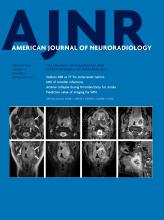Abstract
BACKGROUND AND PURPOSE: Perivascular spaces surround the blood vessels of the brain and are involved in neuroimmune functions and clearance of metabolites via the glymphatic system of the brain. Enlarged perivascular spaces could be a marker of dysfunction in these processes and, therefore, are highly relevant to monitoring disease activity in MS. This study aimed to compare the number of enlarged perivascular spaces in people with relapsing MS with MR imaging markers of inflammation and brain atrophy.
MATERIALS AND METHODS: Fifty-nine patients (18 with clinically isolated syndrome, 22 with early and 19 with late relapsing-remitting MS) were scanned longitudinally (mean follow-up duration = 19.6 [SD, 0.5] months) using T2-weighted, T1-weighted, and FLAIR MR imaging. Two expert raters identified and counted enlarged perivascular spaces on T2-weighted MR images from 3 ROIs (the centrum semiovale, basal ganglia, and midbrain). Baseline and change with time in the number of enlarged perivascular spaces were correlated with demographics and lesion and brain volumes.
RESULTS: Late relapsing-remitting MS had a greater average number of enlarged perivascular spaces at baseline at the level of the basal ganglia (72.3) compared with early relapsing-remitting MS (60.5) and clinically isolated syndrome (54.7) (F = 3.4, P = .042), and this finding correlated with lesion volume (R = 0.44, P = .0004) but not brain atrophy (R = −0.16). Enlarged perivascular spaces increased in number with time in all regions, and the rate of increase did not differ among clinical groups.
CONCLUSIONS: Enlarged perivascular spaces at the level of the basal ganglia are associated with greater neuroinflammatory burden, and the rate of enlargement appears constant in patients with relapsing-remitting disease phenotypes.
ABBREVIATIONS:
- BPF
- brain parenchymal fraction
- CIS
- clinically isolated syndromes
- EDSS
- Expanded Disability Status Scale
- ePVS
- enlarged perivascular spaces
- PVS
- perivascular spaces
- RRMS
- relapsing-remitting MS
- © 2022 by American Journal of Neuroradiology












